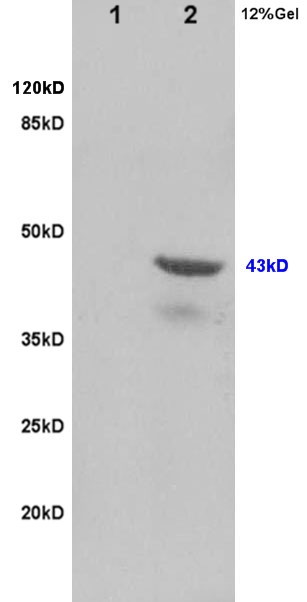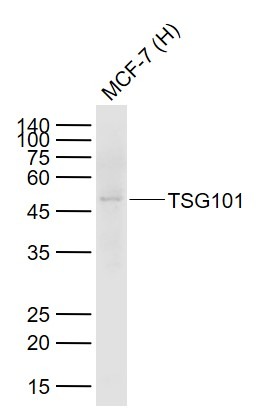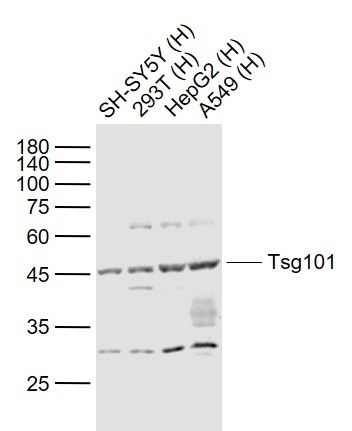Shopping Cart
Remove All Your shopping cart is currently empty
Your shopping cart is currently empty
Anti-TSG101 Polyclonal Antibody is a Rabbit antibody targeting TSG101. Anti-TSG101 Polyclonal Antibody can be used in IF,IHC-Fr,WB.
| Pack Size | Price | USA Warehouse | Global Warehouse | Quantity |
|---|---|---|---|---|
| 50 μL | $221 | 7-10 days | 7-10 days | |
| 100 μL | $373 | 7-10 days | 7-10 days | |
| 200 μL | $527 | 7-10 days | 7-10 days |
| Description | Anti-TSG101 Polyclonal Antibody is a Rabbit antibody targeting TSG101. Anti-TSG101 Polyclonal Antibody can be used in IF,IHC-Fr,WB. |
| Ig Type | IgG |
| Reactivity | Human,Rat (predicted:Mouse,Dog,Cow,Horse,Rabbit) |
| Verified Activity | 1. Sample: Lane1: Brain (Rat) Lysate at 30 μg Lane2: Heart (Rat) Lysate at 30 μg Primary: Anti-Tsg101 (TMAB-01910) at 1:200 dilution; Secondary: HRP conjugated Goat-Anti-Rabbit Igg (bse-0295G) at 1: 3000 dilution; Predicted band size: 43 kDa Observed band size: 43 kDa 2. Sample: Lane 1: MCF-7 (Human) Cell Lysate at 30 μg Primary: Anti-TSG101 (TMAB-01910) at 1/500 dilution Secondary: IRDye800CW Goat Anti-Rabbit IgG at 1/20000 dilution Predicted band size: 46 kDa Observed band size: 46 kDa 3. Sample: Lane 1: SH-SY5Y (Human) Cell Lysate at 30 μg Lane 2: 293T (Human) Cell Lysate at 30 μg Lane 3: HepG2 (Human) Cell Lysate at 30 μg Lane 4: A549 (Human) Cell Lysate at 30 μg Primary: Anti-Tsg101 (TMAB-01910) at 1/1000 dilution Secondary: IRDye800CW Goat Anti-Rabbit IgG at 1/20000 dilution Predicted band size: 46 kDa Observed band size: 46 kDa    |
| Application | |
| Recommended Dose | WB: 1:500-2000; IHC-Fr: 1:100-500; IF: 1:100-500 |
| Antibody Type | Polyclonal |
| Host Species | Rabbit |
| Subcellular Localization | Cytoplasm. Membrane; Peripheral membrane protein. Nucleus. Late endosome membrane; Peripheral membrane protein. Note=Mainly cytoplasmic. Membrane-associated when active and soluble when inactive. Depending on the stage of the cell cycle, detected in the nucleus. Colocalized with CEP55 in the midbody during cytokinesis. |
| Tissue Specificity | Heart, brain, placenta, lung, liver, skeletal, kidney and pancreas. |
| Construction | Polyclonal Antibody |
| Purification | Protein A purified |
| Appearance | Liquid |
| Formulation | 0.01M TBS (pH7.4) with 1% BSA, 0.02% Proclin300 and 50% Glycerol. |
| Concentration | 1 mg/mL |
| Research Background | The protein encoded by this gene belongs to a group of apparently inactive homologs of ubiquitin-conjugating enzymes. The gene product contains a coiled-coil domain that interacts with stathmin, a cytosolic phosphoprotein implicated in tumorigenesis. The protein may play a role in cell growth and differentiation and act as a negative growth regulator. In vitro steady-state expression of this tumor susceptibility gene appears to be important for maintenance of genomic stability and cell cycle regulation. Mutations and alternative splicing in this gene occur in high frequency in breast cancer and suggest that defects occur during breast cancer tumorigenesis and/or progression. [provided by RefSeq, Jul 2008] |
| Immunogen | KLH conjugated synthetic peptide: human Tsg101 |
| Antigen Species | Human |
| Gene Name | Tsg101 |
| Gene ID | |
| Protein Name | Tumor susceptibility gene 101 protein |
| Uniprot ID | |
| Biology Area | Cell cycle inhibitors,Cell differentiation,Cell Cycle Inhibitors,Cell Cycle Inhibitors,Cell Differentiation,Host Virus Interaction |
| Function | Component of the ESCRT-I complex, a regulator of vesicular trafficking process. Binds to ubiquitinated cargo proteins and is required for the sorting of endocytic ubiquitinated cargos into multivesicular bodies (MVBs). Mediates the association between the ESCRT-0 and ESCRT-I complex. Required for completion of cytokinesis; the function requires CEP55. May be involved in cell growth and differentiation. Acts as a negative growth regulator. Involved in the budding of many viruses through an interaction with viral proteins that contain a late-budding motif P-[ST]-A-P. This interaction is essential for viral particle budding of numerous retroviruses. |
| Molecular Weight | Theoretical: 44 kDa. |
| Stability & Storage | Store at -20°C or -80°C for 12 months. Avoid repeated freeze-thaw cycles. |
| Transport | Shipping with blue ice. |
| Size | Quantity | Unit Price | Amount | Operation |
|---|

Copyright © 2015-2026 TargetMol Chemicals Inc. All Rights Reserved.